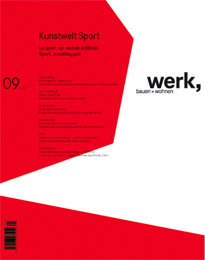Editorial
In 2002 the broadcasting rights for the World Cup were worth 1.5 billion Swiss francs. The sport-dominated commercial network, which also includes the tourism, entertainment and leisure industries, produces powerful identification fields and delivers relevant spatial experiences. The theme of this issue is not so much stadium architecture as the emergence of synthetic landscapes and hybrid building programmes as a result of contemporary sport's economies. Its protagonists, strategies and spatial needs are catalysts for post-industrial urban production; its imagery has taken on a leading role in changing the focus of public space, just as sports goods manufacturers, operating with images and atmosphere, were the pioneers of branding. Sport now has a home advantage in designing urban public space: this is where the sensationally physical meets the constraints of economic evaluation and media representation. The removal of material qualities produces new physical fetishes in architecture and sport alike. Thus for example in the USA there are whole private broadcasting stations devoted to proper TV encounters between dysfunctional body-builders. The tattooed „Professional Wrestling“ colossuses inflict minimum damage for maximum effect, while the equally popular „Women's Wrestling“ stars revel in both competition and eroticism. Their telegenic bodies, usually recruited from the world of strippers, construct and display simultaneously, even more so than the bodybuilders' torsos. What counts in media-made sports is simply the appearance of physical performance. To this extent the degree of staging is reminiscent of the plotless theatrical energy described by Koolhaas in «Delirious New York»: metropolitan mobility transcended by artful performance of co- ordinated women's bodies in the legendary Radio City Music Hall Shows. Nowadays the requirements of traditional mass sport are confronted with an informally programmed and hedonistically specialized sporting culture. This broadening out is one of the requirements of the «sportification» of society, as examined by the Zurich sports sociologists Markus Lamprecht and Hanspeter Stamm, and now reaching the point of market saturation. Sports producing actual self-development techniques alongside rituals and life-styles obey the current market dynamics of mass customization as do other products. It is thus an anachronism given a shift of this kind that sports policy and sports teacher training are under the same ministry as the army in Switzerland. As various examples in this issue show, sport today is less about transferring everyday sets of orders into leisure than defining counter-worlds and concepts of beauty. The latter are increasingly a question of remodelling the body, so that current sports obsessions illustrate a Modernist narrative: the creation of new man. This design, which in the twenties might still have been in the interests of a disciplinary society, is available to flexible Postmodern man as a bio-technical option.
André Bideau (Translation: Michael Robinson)
